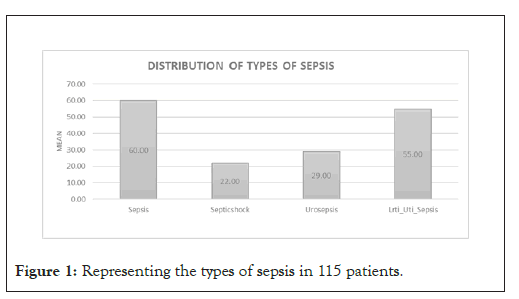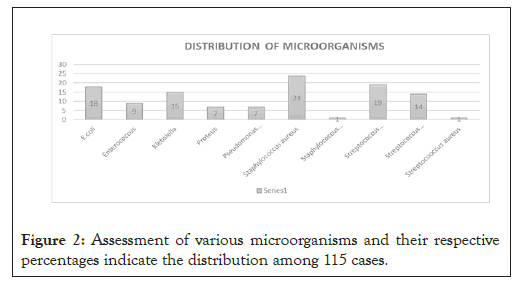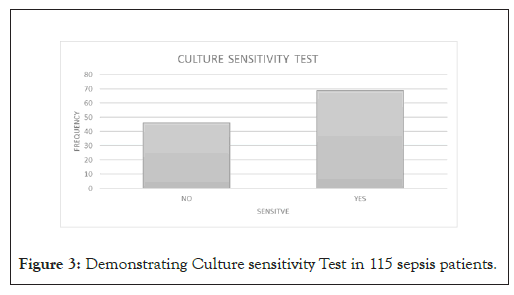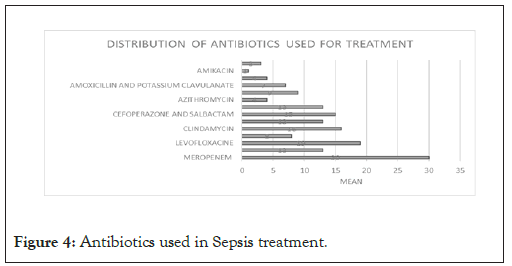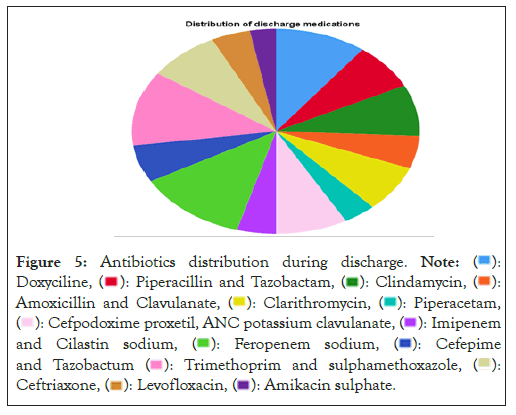Indexed In
- Open J Gate
- Genamics JournalSeek
- CiteFactor
- Cosmos IF
- Scimago
- Ulrich's Periodicals Directory
- Electronic Journals Library
- RefSeek
- Hamdard University
- EBSCO A-Z
- Directory of Abstract Indexing for Journals
- OCLC- WorldCat
- Proquest Summons
- Scholarsteer
- ROAD
- Virtual Library of Biology (vifabio)
- Publons
- Geneva Foundation for Medical Education and Research
- Google Scholar
Useful Links
Share This Page
Journal Flyer

Open Access Journals
- Agri and Aquaculture
- Biochemistry
- Bioinformatics & Systems Biology
- Business & Management
- Chemistry
- Clinical Sciences
- Engineering
- Food & Nutrition
- General Science
- Genetics & Molecular Biology
- Immunology & Microbiology
- Medical Sciences
- Neuroscience & Psychology
- Nursing & Health Care
- Pharmaceutical Sciences
Research Article - (2024) Volume 16, Issue 2
Clinical Observation of Treatment Efficacy in Sepsis: A Prospective Study
Mir Mansoor Sultan*, Adeeba Younus, Durre Shahwar Fatima and Faria MushtaqReceived: 05-Feb-2024, Manuscript No. BLM-24-24826; Editor assigned: 07-Feb-2024, Pre QC No. BLM-24-24826 (PQ); Reviewed: 21-Feb-2024, QC No. BLM-24-24826; Revised: 28-Feb-2024, Manuscript No. BLM-24-24826 (R); Published: 07-Mar-2024, DOI: 10.35248/0974-8369.23.16.357
Abstract
Objective: To examine the safety and efficacy associated with various treatment approaches and to identify trends and variations in the management of severe sepsis, including the usage of antibiotics, and supportive care. To examine factors associated with improved or worsened outcomes in severe sepsis cases, such as patient demographics, comorbidities, or timing of treatment.
Design: A hospital-based prospective study was done on all inpatients and outpatients in Princess Durru Shehvar Children's and General Hospital, Hyderabad, Telangana for 6 months.
Methods: The data collection form and patient consent form were designed for this study. It comprises information regarding the study subject's data such as demographics, medical and medication history, laboratory investigations, diagnosis, present prescribed medication, and progress chart. Investigators collected the relevant data and recorded it in data collection form. The prescription will be selected based on inclusion criteria and exclusion criteria. The data obtained was compiled and analysed using appropriate statistical tests. Quantitative variables were summarized using descriptive studies (percentages, mean, standard deviation, number of observations). The data was statistically analyzed using spss and pair t-test, graphs, pie diagrams, and bar graphs.
Results: A total of 115 patients were included in this prospective study and 60% of them show culture sensitivity. Meropenem was found to be the most potent antibiotic. The analysis of the treatment’s impact reveals noteworthy outcomes across multiple parameters. The intervention demonstrates a significant effect in reducing systolic blood pressure, although no major influence on diastolic blood pressure is observed. Regarding Erythrocyte Sedimentation Rate (ESR), a substantial and statistically significant decrease is indicated post-treatment. Notably, Arterial Blood Gas (ABG) levels exhibit a considerable difference pre and post-treatment, with a p-value below 0.05, suggesting a rejection of the null hypothesis. Additionally, the treatment is associated with a significant increase in total leukocyte counts, as evidenced by the positive mean difference and a 95% confidence interval entirely above zero. These findings underscore the diverse impacts of the treatment on various physiological markers.
Conclusion: Prospective sepsis treatment studies offer a nuanced grasp of real-world effectiveness, linking controlled experiments to clinical reality. Despite biases, they contribute to evidence-based strategies, acknowledging clinical complexities. This practical approach guides healthcare professionals with adaptable, patient-centered methods. Emphasis on rigorous statistical methodologies enhances comprehension. Integrating observational and experimental data enriches our understanding of sepsis management. Overall, these studies shape holistic approaches for effective treatment.
Keywords
Severe sepsis; Antibiotics; Prospective study; Meropenem; Treatment efficacy; Culture sensitivity; Patient- centered methods; Statistical methodologies; Real-world effectiveness; Clinical complexity
Introduction
Sepsis is a life-threatening condition caused by the body's extreme response to an infection. This heightened response can lead to organ damage, and individuals of advanced age, infants, or those Individuals with pre-existing health conditions are particularly susceptible. While bacteria are the primary cause of infection, other pathogens such as viruses or fungi can also trigger infection or septicemia. Clinically, Septicemia is divided into 3 stages, with key diagnostic criteria including alterations in mental status, increased respiratory rate, and decreased blood pressure. Notably, sepsis itself is not contagious. Treatment typically involves hospitalization, intravenous antibiotics, and supportive measures to address organ failure [1-3].
The presence of Gram-positive cocci and Gram-negative bacilli bacteria in the blood heightens the likelihood of progressing to severe sepsis or septic shock within the first month in the ICU (Intensive Care Unit). Moreover, the timing of sepsis diagnosis impacts survival rates, with individuals initially clinically diagnosed with septic shock having an elevated risk of mortality within 28 days (about 4 weeks). Progression to severe sepsis and/or septic shock during the first week further increases the probability of mortality [4].
Urosepsis and septic shock were the common types detected along with LRTI/UTI (Lower Respiratory Tract Infection/Urinary Tract Infection) Sepsis. Antibiotics are the first line of defense against urosepsis and must be administered quickly and quickly to eliminate the bacteria that causes the infection [3].
The main objective of the study was to examine the safety and efficacy associated with various treatment approaches. Identify trends and variations in the management of severe sepsis, including the usage of antibiotics, and supportive care and to examine factors associated with improved or worsened outcomes in severe sepsis cases, such as patient demographics, comorbidities, or timing of treatment [5-8].
Materials and Methods
Design and duration of study
A hospital-based prospective study was done on all inpatients and outpatients in Princess Durru Shehvar Children's and General Hospital, Hyderabad, Telangana for a period of 6 months.
Study population: The individuals who are diagnosed with sepsis and are being given antibiotics were considered. The sample size was 115.
Study method: Permission will be taken by higher authorities to obtain the data. The data collection form and patient consent form were designed for this study. It comprises information regarding the study subject's data such as demographics, medical and medication history, laboratory investigations, diagnosis, present prescribed medication, and progress chart. Investigators collected the relevant data and recorded it in data collection form. The prescription was selected based on inclusion criteria and exclusion criteria.
Statistical analysis
The data obtained was compiled and analysed using appropriate statistical tests. Quantitative variables were summarized using descriptive studies (percentages, mean, standard deviation, number of observations). The data was statistically analysed using spss and pair t-test, graphs, pie diagrams, and bar graphs. Comparison was done for parameters such as total leukocyte count, platelet count, BP, PR, RR, ESR, etc. which gave results that showed the impact of treatment on septic condition.
Results and Discussion
Types of sepsis
A total of 115 patients were identified with septic shock, sepsis, urosepsis and LRTI/UTI sepsis. Sepsis was found in most of the individuals (60 patients), urosepsis (29 patients), LRTI/UTI Sepsis (55 patients) and septic shock being the least (22 patients) (Table 1) (Figure 1).
| Paired sample correlations | BP | N | Correlation | Sig |
|---|---|---|---|---|
| Pair 1 | Systolic BP before treatment and systolic BP after treatment | 115 | 0.057 | 0.542 |
| Pair 2 | Diastolic BP before treatment and diastolic BP after treatment | 85 | -0.064 | 0.558 |
Table 1: Paired T-test For Blood Pressure.
Figure 1: Representing the types of sepsis in 115 patients.
Types of microorganisms
The study involved the assessment of various microorganisms, and their respective percentages indicate the distribution among 115 cases. Notably, Escherichia coli (E. coli) constituted 15.7%, Enterococcus 7.8%, Klebsiella 13.0%, Proteus 6.1%, Pseudomonas aeruginosa 6.1%, Staphylococcus aureus 20.9%, Staphylococcus pneumonia 0.9%, Streptococcus pneumoniae 16.5%, Streptococcus pyogenes 12.2%, and another instance of Staphylococcus aureus at 0.9%. The total sums up to 100%. These findings serve as a foundation for evaluating the impact of the treatment on the diverse microbial composition observed in the study. Further analysis can delve into changes in specific microorganism counts and their responses to the treatment (Table 2) (Figure 2).
| Paired sample correlations | ESR | N | Correlation | Sig |
|---|---|---|---|---|
| Pair 1 | ESR before treatment and ESR after treatment | 115 | 0.4 | 0 |
Table 2: Paired T-test For Erythrocyte Sedimentation Rate [ESR].
Figure 2: Assessment of various microorganisms and their respective percentages indicate the distribution among 115 cases.
Culture sensitivity test
In the study involving 115 sepsis patients, approximately 60% (69 patients) demonstrated culture sensitivity. This indicates a substantial portion of the patient population that exhibited responsiveness to the tested antimicrobial agents (Table 3) (Figure 3).
| Paired sample correlations | Abg | N | Correlation | Sig |
|---|---|---|---|---|
| Pair 1 | ABG before treatment and ABG after treatment | 115 | 0.12 | 0.201 |
Table 3: Paired T-Test for Abg.
Figure 3: Demonstrating Culture sensitivity Test in 115 sepsis patients.
Antibiotics used in treatment
Antibiotics are considered as first line treatment for sepsis which is administered to eradicate the bacteria causing infection. The variety of prescribed antibiotics suggests a comprehensive approach, targeting different types of bacteria and infections.
The high count of Meropenem may indicate its effectiveness against a wide range of pathogens, and its application in complex or severe cases.
Combination antibiotics like Cefepime and Tazobactam, Cefoperazone and sulbactam, and Piperacillin and Tazobactam are prescribed, indicating a strategy to cover a wide range of potential pathogens.
The presence of antibiotics like Doxycycline, Azithromycin, and Amoxicillin and Potassium Clavulanate suggests consideration for some types of infections, like those that affect the skin, soft tissues, or the respiratory system (Table 4) (Figure 4).
| Paired sample correlations | Leukocyte | N | Correlation | Sig |
|---|---|---|---|---|
| Pair 1 | Total leukocytes before treatment and total leukocytes after treatment | 115 | 0.513 | 0 |
Table 4: Paired t-test for total leukocytes.
Figure 4: Antibiotics used in Sepsis treatment.
Discharge medication
Upon discharge, a tailored medication plan was instituted for the 115 sepsis patients, reflecting a personalized approach to treatment. Approximately 60% of these individuals exhibited culture sensitivity, influencing the prescription of targeted antimicrobial agents. The discharge medications encompassed specific antibiotics based on the identified microbial responses, addressing the diverse microorganism profiles observed in the study (Figure 5).
Figure 5: Antibiotics distribution during discharge. Note: ( ): Doxyciline, (
): Doxyciline, ( ): Piperacillin and Tazobactam, (
): Piperacillin and Tazobactam, ( ): Clindamycin, (
): Clindamycin, ( ): Amoxicillin and Clavulanate, (
): Amoxicillin and Clavulanate, ( ): Clarithromycin, (
): Clarithromycin, ( ): Piperacetam, (
): Piperacetam, ( ): Cefpodoxime proxetil, ANC potassium clavulanate, (
): Cefpodoxime proxetil, ANC potassium clavulanate, ( ): Imipenem and Cilastin sodium, (
): Imipenem and Cilastin sodium, ( ): Feropenem sodium, (
): Feropenem sodium, ( ): Cefepime and Tazobactum (
): Cefepime and Tazobactum ( ): Trimethoprim and sulphamethoxazole, (
): Trimethoprim and sulphamethoxazole, ( ): Ceftriaxone, (
): Ceftriaxone, ( ): Levofloxacin, (
): Levofloxacin, ( ): Amikacin sulphate.
): Amikacin sulphate.
Paired T-test
Paired T-test for Blood Pressure: The treatment appears to have a significant effect on reducing systolic blood pressure, but no significant effect on diastolic blood pressure based on the given data.
Paired T-test for Esr: The results suggest that there is a significant difference between ESR before and after treatment. The positive mean difference and the 95% confidence interval being entirely above zero indicate that the treatment is associated with a statistically significant decrease in ESR.
Paired T-Test for Abg: The results suggest that there is a large difference between ABG levels before and after treatment. The p-value is lower than the common significance level of 0.05, indicating that we pass to reject the null hypothesis.
Paired T-test for total leukocytes: The results suggest that there is a significant difference between total leukocyte counts before and after treatment. The positive mean difference and the 95% confidence interval being entirely above zero indicate that the treatment is associated with a statistically significant increase in total leukocyte counts.
In our discussion, our prospective study provided valuable direct insights into the effectiveness of sepsis treatment, offering real- world context and practical implications for clinicians through active observation and measurement of treatment outcomes. In contrast, the referenced topic review by Gregory A Schmidt and Jess Mandel presented a broader perspective on sepsis management, establishing general principles, approaches, and overarching strategies. The review, aligning with the 2021 Surviving Sepsis Campaign guidelines, emphasized the critical role of early blood cultures, a sentiment reinforced by a multicenter randomized trial highlighting the sensitivity of post-antimicrobial blood cultures. This synthesis of direct observation and established principles contributes to a more holistic understanding of effective sepsis management.
Conclusion
In summary, the evaluation of sepsis treatments through prospective studies offers a nuanced understanding of their real- world effectiveness, considering diverse patient demographics and uncontrolled variables. This practical approach, despite potential biases, serves as a crucial link between controlled experiments and the complexities of everyday clinical practice. The knowledge gained from these investigations contributes to evidence-based and patient-centered treatment strategies, recognizing the intricacies of sepsis management. While emphasizing the need for rigorous statistical methodologies, the integration of observational and experimental data enriches our comprehension, guiding healthcare professionals toward holistic and adaptable approaches in addressing the complexities of sepsis treatment.
References
- World Health Organization: WHO & World Health Organization. Sepsis.
- Davis CP. Sepsis (Blood Poisoning): Septicaemia, Causes, Treatment, 3 Stages & Risks. Medicine Net.
- The stages of sepsis. News-Medical.net. 2018.
- O’Connell K. Sepsis symptoms, causes and recovery. Healthline. 2023.
- Arora J, Mendelson AA, Fox‐Robichaud A. Sepsis: Network pathophysiology and implications for early diagnosis. American Journal of Physiology-regulatory Integrative and Comparative Physiology. Am J Physiol. 324(5):613-624.
- Septic Shock: practice essentials, background, pathophysiology. Medscape. 2020.
- Howell MD, Davis AM. Management of sepsis and septic shock. Jama. 2017;317(8):847-848.
- Seymour CW, Rosengart MR. Septic shock: Advances in diagnosis and treatment. Jama. 2015. 18;314(7):708-717.
Citation: Sultan MM, Younus A, Fatima DS, Mushtaq F. (2024) Clinical Observation of Treatment Efficacy in Sepsis: A Prospective Study. Bio Med. 16:357.
Copyright: © 2024 Sultan MM, et al. This is an open-access article distributed under the terms of the Creative Commons Attribution License, which permits unrestricted use, distribution, and reproduction in any medium, provided the original author and source are credited.



